The symbols of Brussels are the objects, images, or cultural expressions that are emblematic, representative, or otherwise characteristic of Brussels or Brussels culture. As a rule, these national symbols are cultural icons that have emerged from Brusselian folklore and tradition, meaning few have any official status. However, most if not all maintain recognition at a national or international level, and some, such as the flag of the Brussels-Capital Region, have been codified in, and are established, official, and recognised symbols of Brussels.
Flag
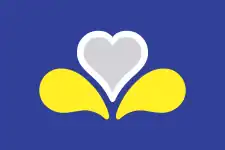 |
The flag of the Brussels-Capital Region consists of a stylized yellow iris on a blue background. |
 |
The flag of the Flemish Community Commission consists of the former flag of the Brussels-Capital Region and the flag of Flanders. |
 |
The flag of the French Community Commission consists of the former flag of the Brussels-Capital Region and the flag of Wallonia. |
Cultural
 |
Saint Verhaegen often shortened to St V is an annual holiday celebrating the founding of the Free University of Brussels and its founder held on 20 November. |
 |
The Ommegang, a folkloric costumed procession, commemorating the Joyous Entry of Emperor Charles V and his son Philip II in the city in 1549, takes place every year in July. |
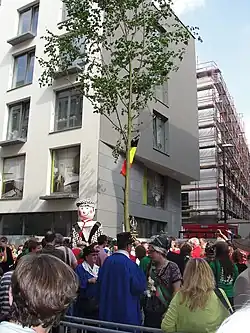 |
The Meyboom is an annual tradition in Brussels dating back to the 13th century, featuring the planting of a symbolic maypole on August 9 to celebrate the city's folklore. |
.jpg.webp) |
The Royal Theatre Toone is a typical puppet theater, playing in the local dialect known as Brusselian, with a legacy dating back to 1830. Renowned for its commitment to traditional Brussels-style puppetry known as poechenelle. |
 |
The Manneken-Pis is a bronze statue depicting a small boy urinating into a fountain. It is recognized as depicting the playful spirit of the Brusselians known as zwanze and historical tradition of being adorned in diverse costumes reflecting various themes and events. |
Fauna and flora
 |
The Brussels Griffon a breed of toy dog originating in the city. |
 |
The yellow iris is the floral emblem of Brussels. |
 |
Brussels sprouts a cultivar group of cabbages originating in the city. |
Food and drink
 |
Brussels waffle, type of waffle dating back to the 18th century. |
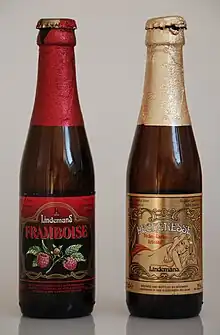 |
Lambic and its derived beers. |
 |
Pralines type of chocolate invented by the chocolatier Jean Neuhaus II in the Royal Saint-Hubert Galleries. |
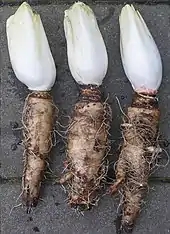 |
Witloof are blanched endives was accidentally discovered in the 1850s at the Botanical Garden of Brussels. |
 |
Type of biscuit developed in the 20th century, as an alternative for people who could not afford Dutch speculaas. |
People
 |
Saint Michael the Archangel the patron saint of Brussels together with Saint Gudula. |
 |
Saint Gudula the patron saint of Brussels together with Saint Michael the Archangel. |
 |
Herkenbald was a legendary magistrate of Brussels who is said to have lived in the around 1020. He was considered the example of an incorruptible judge. |
.jpg.webp) |
Everard t'Serclaes, national hero and Lord of Kruikenburg during the War of the Brabantian Succession. |
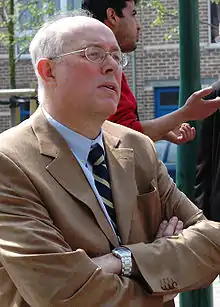 |
Charles Picqué, the first Minister-president of the Brussels Capital-Region regarded as "Father of the Nation".[1] |
Miscellaneous
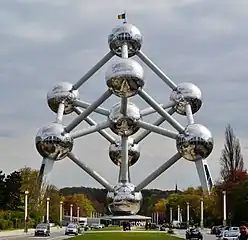 |
The Atomium, a symbolic 103 m-tall (338 ft) modernist structure built for Expo 58. It consists of nine steel spheres connected by tubes, and forms a model of an iron crystal magnified 165 billion times. |
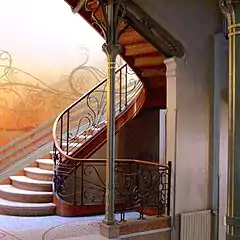 |
Art Nouveau, prominent art style in the late 19th and early 20th centuries, is characterized by ornate and organic designs. Architects such as Victor Horta and Henry van de Velde significantly contributed to the city's artistic landscape, leaving a lasting impact with their buildings and decorative arts featuring flowing lines and nature-inspired motifs. |
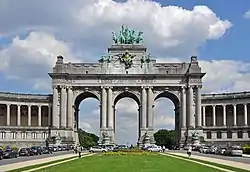 |
The Cinquantenaire is an expansive public park located in the European Quarter, recognized for its triumphal arch constructed for the Brussels International Exposition. Serving both cultural and recreational purposes, the park encompasses museums such as the Art & History Museum and Autoworld. |
 |
Brussels lace type of pillow lace that originated in and around the city. |
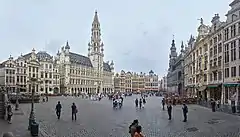 |
The Grand Place, is a historically significant and Brussels' central square known for its well-preserved medieval and baroque architecture, prominently featuring the Town Hall and guildhalls. The square serves as a venue for various events, cultural festivals, and markets, contributing to its status as a central gathering place with a diverse array of activities throughout the year. |
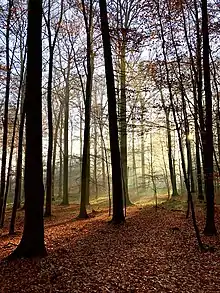 |
The Sonian Forest, is a large and ancient forest located southeast of Brussels. Stretching across the three federal regions of Belgium, the forest is characterized by diverse ecosystems, including beech and oak woodlands, and is a significant natural and recreational area for residents and visitors. |
Municipal symbols
City of Brussels
| Coat of arms of the City of Brussels | |
|---|---|
 | |
| Versions | |
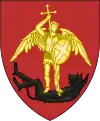 Lesser version | |
| Blazon | Archangel Michael slaying the Devil |
| Supporters | Two lions argent, each holding a banner. The two banners show the coats of arms of respectively Brabant and the City of Brussels. |
| Compartment | Mount vert |
| Other elements | Two crossed flags |
Coat of arms
The coat of arms of the City of Brussels shows two lions on a grassy mount supporting a red shield. The motif of the escutcheon is a golden Archangel Michael (the patron saint of Brussels) slaying a black Devil by piercing it with a spear shaped like a cross. Other elements include two crossed flags behind the shield; one showing a lion on a black field and the other repeating the motif of the shield on a red field.
A lesser version of the coat of arms which includes the shield only, is also common.
.svg.png.webp) Greater arms as depicted in 1730
Greater arms as depicted in 1730.svg.png.webp) Greater arms as seen in this First French Empire version
Greater arms as seen in this First French Empire version Depicted by Hugo Gerard Ströhl in Heraldischer Atlas, Stuttgart, 1899
Depicted by Hugo Gerard Ströhl in Heraldischer Atlas, Stuttgart, 1899
Flag
The municipal flag of Brussels (City of Brussels), as flown from the Town Hall and other buildings is a rectangle, divided horizontally with green over red, with a very large version of the municipal logotype in the centre, and a stylised, disc-shaped silhouette of St. Michael trampling the devil, in dark yellow. It is essentially the same motif as the coat of arms.
Other
| Municipality | Flag | Coat of arms | |
|---|---|---|---|
| Lesser version | Greater version | ||
| Anderlecht |  |
 |
— |
| Auderghem |  |
 |
— |
| Sint-Agatha-Berchem |  |
 |
— |
| City of Brussels | 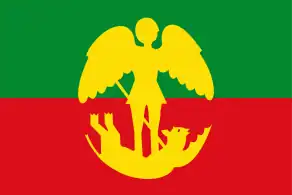 |
 |
 |
| Etterbeek |  |
 |
— |
| Evere |  |
 |
 |
| Vorst |  |
 |
— |
| Ganshoren |  |
 |
— |
| Ixelles |  |
 |
— |
| Jette |  |
 |
 |
| Koekelberg |  |
.svg.png.webp) |
|
| Sint-Jans-Molenbeek |  |
 |
— |
| Sint-Gillis |  |
||
| Sint-Joost-ten-Noode |  |
 |
 |
| Schaarbeek |  |
 |
— |
| Ukkel |  |
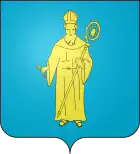 |
— |
| Watermaal-Bosvoorde |  |
 |
— |
| Sint-Lamberts-Woluwe |  |
 |
 |
| Sint-Pieters-Woluwe |  |
 |
 |
See also
References
- ↑ "Charles Picqué, vader van het Brussels Gewest: 'Brussel mag geen twistappel worden'". www.bruzz.be (in Dutch). Retrieved 2023-12-23.
